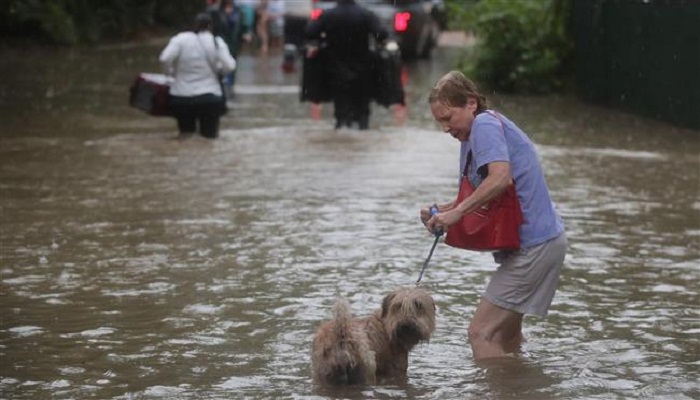Houston devastated by flooding; residents gird for more rains
YemenExtra
Catastrophic flooding triggered by Tropical Storm Harvey inundated Houston on Sunday, forcing residents of the fourth most populous US city to flee their homes in boats or hunker down in anticipation of several more days of “unprecedented” rainfall.
Harvey came ashore late on Friday as the most powerful hurricane to hit Texas in more than 50 years and has killed at least two people. The death toll is expected to rise as the storm triggers additional tidal surges and tornadoes, with parts of the region expected to see a year’s worth of rainfall in the span of a week.
The storm caused chest-deep flooding on some streets in Houston as rivers and channels overflowed their banks. More than 30 inches (76 cm) of rain had fallen in parts of Houston in the past 48 hours, the National Weather Service said on Sunday, with more on the way.
The storm struck at the heart of the country’s oil and gas industry, forcing operators to close several refineries and evacuate and close offshore platforms. The massive flooding knocked out 11 percent of US refining capacity and a quarter of oil production from the US Gulf of Mexico.
“What we’re seeing is the most devastating flood event in Houston’s recorded history. We’re seeing levels of rainfall that are unprecedented,” said Steve Bowen, chief meteorologist at reinsurance firm Aon Benfield.
Total precipitation could reach 50 inches (127 cm) in some coastal areas of Texas by the end of the week, or the average rainfall for an entire year. The center of Harvey was about 105 miles (170 km) from Houston and was forecast to arc slowly toward the city through Wednesday.
People in Houston and other areas of Texas were asked not to leave their homes, even if they flooded, as roads were impassable.
President Donald Trump plans to go to Texas on Tuesday to survey damage from the storm, a White House spokeswoman said on Sunday.
Refineries shut down

The Gulf is home to about nearly half of the nation’s refining capacity, and the reduced supply could affect gasoline supplies across the US Southeast and other parts of the country. Shutdowns extended across the coast, including Exxon Mobil’s Baytown refinery, the second largest US refinery.
Gasoline futures rose as much as 7 percent in early trading on Sunday evening, and heating oil futures, a proxy for distillates like diesel fuel, were up as much as 3 percent, as supplies are expected to be curtailed.
The outages will limit the availability of US crude, gasoline and other refined products for global consumers and further push up prices, analysts said.
All Houston port facilities will be closed on Monday because of the weather threat, a port spokeswoman said on Sunday night.
The swift rise of floodwaters surprised authorities, and emergency services told the city’s 2.3 million inhabitants to climb onto the roofs of houses, if necessary.
“The water was right at our door,” said Jasmine Melendez, a 23-year-old Houston mother of three, including a week-old infant. “We were also worried about the kids, especially the baby.”
Melendez was sheltering at the downtown George Brown Convention Center, which was filled with hundreds of people who showed up for water, food and baby supplies. Some people were being brought to the center in city dump trucks.
The Harris County Sheriff’s Office rescued more than 2,000 people in the greater Houston area using vehicles including motorboats, airboats and humvees on Sunday, a spokesman said.
‘Beyond anything experienced before’

Forecasters could only draw on a few analogues to the storm, recalling Hurricane Katrina, which devastated New Orleans in 2005 and killed 1,800 people, and Tropical Storm Allison.
The Harris County Flood Control District said Harvey’s impact would rival that of Allison, which dropped more than 40 inches (102 cm) of rain in Texas in June 2001, flooded 70,000 homes and caused $9 billion in damage.
“The breadth and intensity of this rainfall are beyond anything experienced before. Catastrophic flooding is now underway and expected to continue for days,” the National Weather Service said on Twitter.
Harvey hit Texas as a Category 4 hurricane with winds of 130 miles per hour (210 kph), the strongest storm to hit the state since 1961. As of Sunday evening, about 240,000 people were without power, but Centerpoint Energy, which serves Houston, said it could not give an accurate estimate because flooding was preventing crews from reaching customers.
Two deaths were confirmed so far – one in Rockport, 30 miles (48 km) north of Corpus Christi, and in west Houston on Saturday. The Twitter account for Harris County 911 said people should not call if their lives were not threatened.
Houston’s George Bush Intercontinental and William P. Hobby airports canceled all commercial flights on Sunday. The Ben Taub Hospital in Houston’s Medical Center was evacuated on Sunday. An American Red Cross emergency shelter was forced to shut because of flooding and the group opened two more.

Houston’s schools were scheduled to close for the week, the school district said on Twitter. ConocoPhillips will close on Monday and Tuesday, the company said.
Trump, facing the first big US natural disaster since he took office in January, signed a disaster proclamation on Friday, triggering federal relief efforts. Texas Governor Greg Abbott said on Sunday that 50 counties had been declared state disaster areas.
The Federal Emergency Management Agency said it had more than 400 rescue personnel in South Texas, and 500 others were in the state and expected to be joining in rescue operations on Sunday evening.
Jose Rengel, a 47-year-old construction worker who lives in Galveston, was helping with rescue efforts in Dickinson, Texas, southeast of Houston, where he saw water cresting the tops of cars.
“I am blessed that not much has happened to me, but these people lost everything. And it keeps raining,” he said.
“The water has nowhere to go.”
(Source: Reuters)

